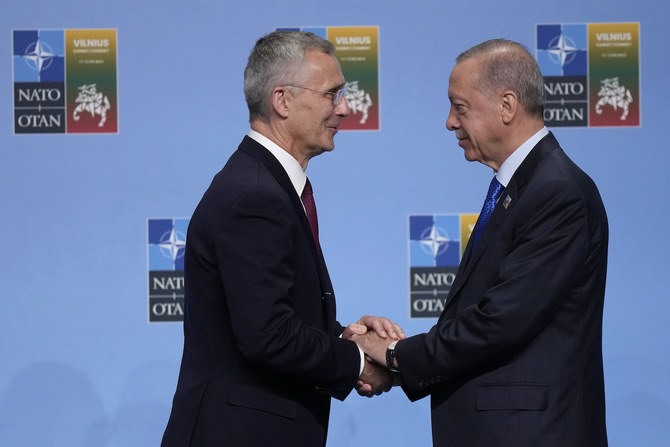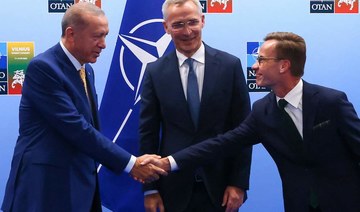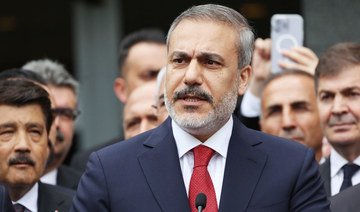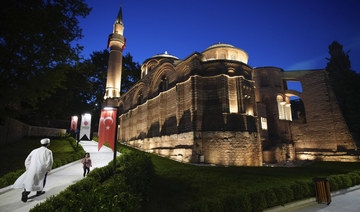ANKARA: In a significant move ahead of the landmark NATO summit in Vilnius, Turkiye has abandoned its resistance to Sweden’s membership bid, raising questions about the concessions Ankara may have secured in return and how its role within the alliance will evolve following this pivotal decision.
Prior to the decision, Turkish President Recep Tayyip Erdogan held a meeting with EU Council chief Charles Michel, in which the pair explored avenues to revive cooperation between Turkiye and the EU and reinvigorate their ties.
Erdogan previously linked Sweden’s NATO bid to the EU’s acceptance of Turkiye, a candidate for the bloc’s membership since 1999, whose accession talks have been frozen since 2018. Turkiye also emphasizes the importance of relaxing visa rules and updating customs union agreements.
Reviving relations with the US and Europe will also strengthen the Turkish economy, helping it draw in foreign investment and support central bank reserves.
Ryan Bohl, a senior analyst for the Middle East and North Africa at the RANE Network, said Turkiye now enjoys full support from Stockholm for its EU membership aspirations.
“While there hasn’t been a breakthrough in terms of resuming EU talks with Turkiye, Stockholm has promised to support Turkish efforts to do so. It also seems that Erdogan has secured promises to enhance economic ties between Turkiye and Sweden,” he told Arab News.
HIGHLIGHT
Erdogan previously linked Sweden’s NATO bid to the EU’s acceptance of Turkiye, a candidate for the bloc’s membership since 1999, whose accession talks have been frozen since 2018
In preparation for the NATO summit, US officials engaged in intensive diplomacy, holding several meetings with their Turkish counterparts. Ahead of their meeting with Erdogan on Tuesday evening, US President Joe Biden expressed his readiness to collaborate with Turkiye in enhancing defense and deterrence in the Euro-Atlantic area.
One of Ankara’s key priorities is the modernization of its F-16 fleet, which Erdogan requested in October 2021 with the $6 billion deal that covers the sale of 40 jets as well as modernization kits for 79 Turkish warplanes.
Bohl said Turkiye’s recent move will be well received in Washington and increase the likelihood of the White House sending the bill regarding the sale of F-16 jets to the Congress.
“There will still be obstacles there because of Turkiye’s human rights record concerns from certain congresspeople, but the White House will likely put their influence to work overcoming that in time,” he added.
On Monday, Chairman of the US Senate Foreign Relations Committee Bob Menendez revealed discussions between Turkiye and the Biden administration regarding the pause placed on the potential sale of F-16s to Ankara were ongoing, indicating that a decision could be reached within the next week.
The White House is also giving positive signals about it, with Biden “clear and unequivocal” on sending F-16s to Turkiye, said US National Security Advisor Jake Sullivan on Tuesday during a news conference in Vilnius.
“This is in our national interest, it’s in the interest of NATO that Turkiye gets that capability,” he added.
During a conversation with CNN’s Fareed Zakaria, Biden signaled that he was working on a deal with Turkiye and Greece to strengthen NATO defense capabilities while facilitating Sweden’s entry into the alliance.
Turkiye will soon present the accession protocol for Sweden to the Turkish parliament, which will subsequently vote on its approval. However, no specific timeline has been announced for Sweden’s immediate membership, and the Turkish parliament, which is mainly controlled by a coalition led by Erdogan’s party, goes on holiday soon.
Turkiye has long accused Sweden of permitting the outlawed Kurdistan Workers’ Party, or PKK, to operate and raise funds, while also criticizing Stockholm for recent Islamophobic demonstrations, including the burning of the Qur’an.
Despite these challenges, the two countries have collaborated closely to address Turkiye’s security concerns. Sweden recently amended its constitution, tightened its anti-terrorism laws, and resumed arms exports to Turkiye. Sweden also cooperated with Turkish security officials to track terrorist activities.
Emre Caliskan, a research fellow at the UK-based Foreign Policy Centre, said this is a typical example of Erdogan’s leadership as the process is always more important than the result for him.
“His aim is to show that Turkiye is an indispensable part of the Western system, but at the same time to send the message that we are not surrendering to you. In doing so, he forced Western leaders, who refused to meet with him before, to call him once a week,” said Caliskan.
Additionally, Turkiye and Sweden have agreed to establish a new bilateral security compact, with Stockholm presenting a roadmap for its ongoing counterterrorism efforts. NATO will also create a special coordinator for counterterrorism within the alliance.
According to Bohl, while Turkiye’s efforts to end defense boycotts by new NATO members Finland and Sweden may enhance cohesion within the alliance, Turkiye is likely to maintain its own working relationship with Russia, potentially positioning Ankara as a NATO outlier in its confrontation with Moscow.
Following Erdogan's victory in the presidential elections in May, the decision not to obstruct Sweden's membership could generate significant political and economic optimism, reinforcing his position amid the ongoing depreciation of the Turkish lira.
Paul T. Levin, director of Stockholm University's Institute for Turkish Studies, doesn’t think Ankara can leverage Swedish NATO accession to force the EU to open up accession negotiations or to push the Customs Union modernization and visa liberalization.
“For instance, Ankara hasn’t fulfilled a number of criteria for visa liberalization, including amendments to its terrorism law. But, I do expect the F-16 deal to go through. US promises of deepening defense cooperation was the pre-condition to get Ankara to say yes to Swedish accession,” he told Arab News.
According to Levin, the bilateral security compact is a way for Ankara and the Turkish audience to feel a little more relaxed about Sweden’s continuous work on counterterrorism efforts after Ankara removed its veto.
“Based on my conversations with Swedish officials, they are serious about being tough on PKK in particular and they won’t backtrack on their fight against terrorism,” he said.
For Levin, Erdogan has gained a position in the center of NATO enlargement affairs with the Swedish accession saga.
“But it is a short-term win. In the long term, Erdogan has damaged Turkiye’s standing within the alliance by appearing as a troublemaker. It is a double-edged sword,” he added.



























